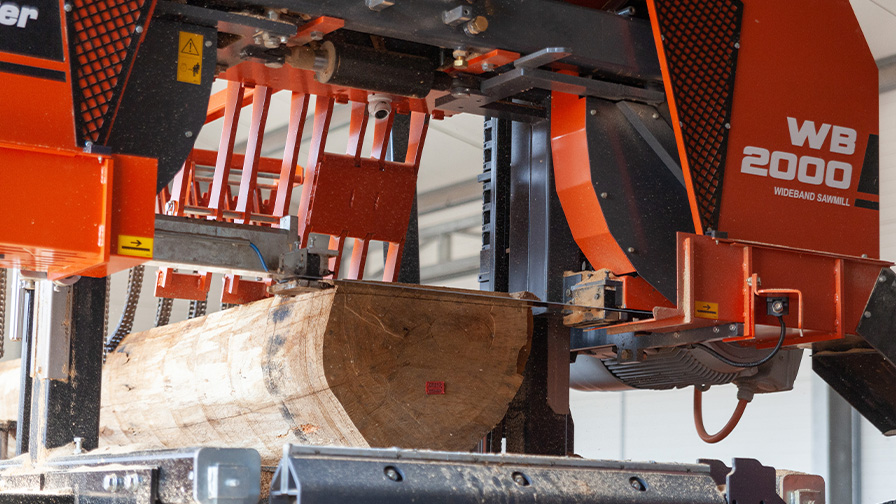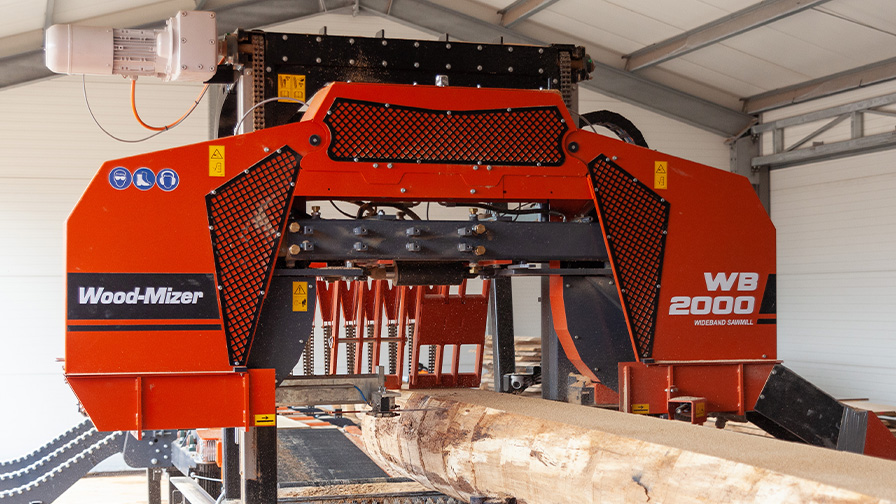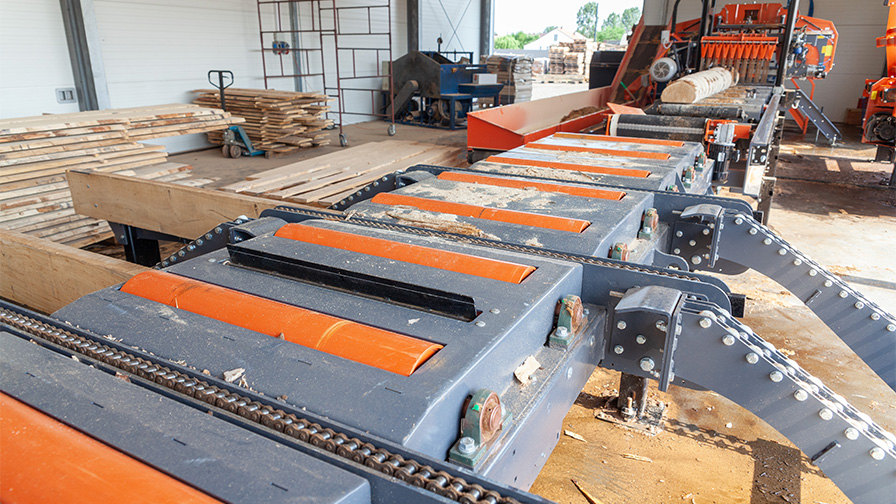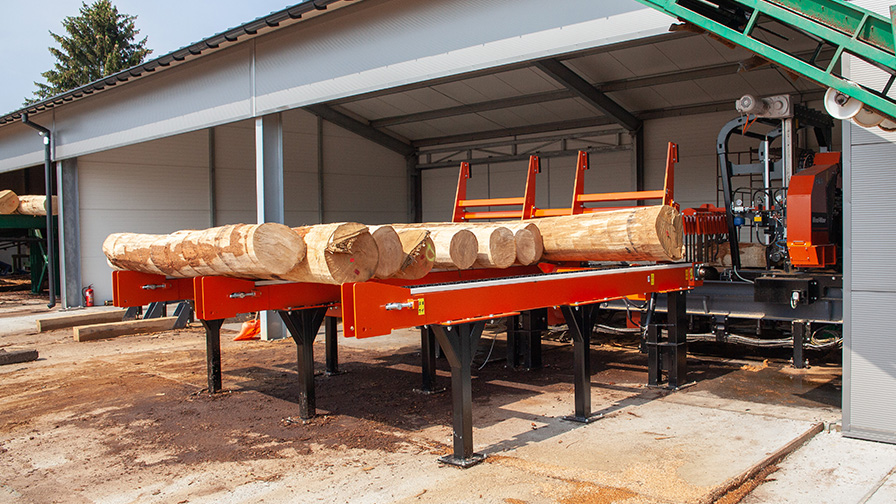Watch the detailed video presentation of Wood-Mizer's industrial cutting line used by the Polish company A&M Trak Michał Nowakowski. The video is presented by Adam Kubiak, Wood-Mizer's industrial equipment sales manager, in cooperation with Nowakowski's employees.
Since the range was launched in 2015, wood processing companies around the world have installed Wood-Mizer WB2000 industrial saws, increasing wood throughput productivity by two or even three times. The Wood-Mizer WB2000 Industrial Wood-Mizer WB2000 is an equipment that combines the benefits of narrow and wide band saw blade technologies. Sawmill operators appreciate its precise saw head, massive bed with efficient hydraulics and ease of operation. The WB2000 can be operated as a stand-alone saw or as part of a wood-cutting line in the configuration that best suits the needs of such an operation.
WB2000 saw head and blades
The WB2000 saw was designed to work with saw blades from 50 mm, 75 mm or 100 mm width installed on 800 mm diameter cast iron handwheels. The use of 50 mm or 75 mm wide blades allows the resharpening and planing of blades on Wood-Mizer maintenance equipment, including the BMS600 sharpening and BMT300 planing machines. "The 100mm blades require a more advanced resharpening process and the operator needs to be more experienced. Most of the WB2000 saws ordered by our customers are pre-configured for 75 mm wide blades," shares Adam Kubiak, Industrial Equipment Sales Manager at Wood-Mizer.

Each steering wheel includes a felt and a scraper for cleaning and lubricating the flywheel surface, while a dosing box is installed behind the cover. Small inspection windows allow the flywheel lubrication to be monitored. The recommended dosage is 2-3 drops of oil per 5 seconds of work on the handwheels.
The WB2000 saw uses the blade cleaning and cooling system LubeMizer. It is a highly efficient mechanism that delivers compressed detergent through nozzles placed below and above the saw blade. It can spray the liquid constantly or in bursts, which is particularly useful when cutting hardwood. The saw head can be optionally equipped with a peeler which considerably extends the life of the blade. The carbide material welded onto the circular teeth of the blade is 5mm wide and makes a small cut in the log, removing bark and dirt and allowing the saw blade to penetrate the clean material. Optionally, the WB2000 can also be equipped with a laser pointer showing the future cut line on the surface of the log.
The blade tensioning system consisting of a hand pump and an oil can maintains the correct tension of the blade during flow. Oil accumulator is responsible for regulating sail tension whenever the sail crosses a more complex structure in the log, such as a knot. If this happens, the sail receives more load and, for a brief moment, it may loosen. The oil accumulator helps to regulate the tension of the blade continuously so that the sawing process runs in a stable and precise way, regardless of the structure of the wood. The WB2000 can be optionally equipped with an electric oil pump powered from the operator panel.
The recommended voltage parameters are specified on a sticker located next to the pump. "An operator must adjust the blade tension correctly as this affects the life of the blade. If the blade does not cut straight, it is recommended to adjust the flywheel or replace it with a new one. It is not good practice to over tension the blade," warns Adam Kubiak.
Main motor and saw head feed system
On the left side of the saw head is main electric motor30 kW or 37.5 kW (optional). The main engine can be equipped with a variable speed drive controlling the linear speed of the blade (18-32 m/s), helping to cut softwood and hardwood.
The WB2000 saw, without a variable speed drive that controls the linear speed of the blade, can operate at two fixed feed speeds - either 22 m/s for softwood or 26 m/s for hardwood. Changing from one speed to the other is done mechanically and requires the replacement of a set of rollers and belts. It is essential to inform Wood-Mizer about the adjustment of the linear speed of the blade (manual or electric) before ordering, as there is no possibility to change the saw later.
The saw head is fed vertically by a helical gearbox highly reliable, known for its high efficiency (97-98%), which allows the use of a 2.2 kW electric motor with less energy input. "The control software used in the saw head feed mechanism is similar to that used in modern elevators. When we need to set the saw head to a certain height, it is moved up and down by the variable speed drive and PLC unit, but once the saw head reaches the required height, the brake is engaged. The brake is only responsible for keeping the head at the required height and not for stopping the head from moving. This solution limits heat emission and helps the whole mechanism to last longer," assures Adam Kubiak.
The units responsible for the horizontal feed of the saw head are located on both sides of the saw frame and are coupled with strong and strong chains. With this mechanism, the massive and wide saw head can be moved accurately and effortlessly along the rails during the sawing operation. The maximum cutting speed is 60 m/min, while in reverse motion the speed can reach up to 100 m/min. The movement of the saw head is controlled by a PLC driver, which constantly analyzes the saw head's position and slows down when the saw head approaches the rear bumpers.
The WB2000 saw is equipped with two cameras for monitoring the cutting process, which are placed on the saw head next to the main motor. The first camera monitors the working blade and the other monitors the reverse movement of the saw head. The image is transmitted to the screen in the operator's cab. The video recorder includes a total of 4 cameras (two additional cameras are optional).
Saw bed and hydraulic log handling system
The frame of the saw is robust and durable, based on two C-shaped steel rails (400 mm wide) that are arranged along the bed. The modular structure allows flexible configuration according to the cutting requirements. The hydraulic functions and equipment of the saw bed are similar to those of other Wood-Mizer saws - a central clamp on two rods, side supports, two chain wheels and three drive rollers that can be controlled separately. There is a 7.5 kW (27 l/min flow) pump to power the hydraulic system; this can optionally be replaced with an 11 kW (50 l/min flow) pump. "Most WB2000 saws are ordered with the standard hydraulic pump, as faster hydraulic systems require advanced operating skills. The operator must react carefully to the bed's fast working functions," notes Adam Kubiak. For operators who need to cut longer logs, it is recommended to extend the saw with grapple clamps, which keep the log fixed to the saw bed.

Nowakowski's WB2000 industrial saw WB2000 was equipped with a belt conveyor adjustable to allow the material to be conveyed to the receiving module (where the sorting table is located). In front of the conveyor is an absorption roller to cushion the impact of a falling plank. Optionally, the WB2000 can be equipped with a tracking conveyor separately. "The tracking conveyor follows the saw head, its angle is opposite to that of a standard conveyor - the tip of the conveyor is raised and so follows the blade. This device is useful when cutting large diameter logs. Those heavy, hard planks can have a tendency to break when they fall on the conveyor (e.g. oak)," explains Adam Kubiak.

One of the most valuable parts of the WB2000 saw is Log Bridge for quick and safe loading of logs onto the bed. The Wood-Mizer log decks are available in 3.6 m and 6 m long versions, with 2 or 3 transport chains. "Sometimes companies order a special configuration of two log decks where one is placed behind the other. The shorter deck is installed inside the production enclosure and the longer one is outside. The outer deck is used for storing enough logs for one shift, and the shorter one is for holding 2-3 logs ready for immediate loading on the saw bed. This is a smart way to limit the opening and closing of the production enclosure in winter and save heat," explains Adam Kubiak. The log deck is also offered in the newest Heavy-Duty version with increased durability.

Behind the saw is a modular sorting table for automatically receiving material and directing it to further processing areas. The individual modules (each 3 m long) can be joined into groups of up to 9 m in length (3 modules in total). The groups can be multiplied to build larger sorting areas. "At the Nowakowski company, the sorting table is electric, with cross chains and pushers. The table can be optionally equipped with pneumatically or hydraulically driven chains. This is a recommended solution for lines where the material is received from two or more sawmills working side by side," explains Adam Kubiak.

A cutting line could also be extended with more machines and equipment, e.g. on the left and right side, slides or collection areas, edging circulars or multi-blade saws could be installed. In addition, a conveyor could be installed to collect the material, transporting the prisms to the multi-blade saw and the wood chips to the chipper.
Convenient WB2000 saw operation
Operator station The WB2000 is built on a raised structure, allowing easy visual control of throughput (optional air-conditioned cab). At A&M Trak Nowakowski, the operator's workplace is conveniently located in a customized cab.
Two joysticks and a 12 inch touch screen are provided to easily control the saw. The screen displays the cutting parameters and settings buttons, while joysticks control the equipment functions. Another screen is installed next to the touchscreen to display the camera image. In the current configuration of the saw, the operator can follow the position of the blade in the log, the bed behind the saw head, the sorting table and the cutter head post.

The operator touch screen works in the HEAD (saw head control) and in the BED (hydraulic system control). After switching the display to the saw head operation function, the display shows information such as saw head height, cutting position, feed speed or current motor load.
Operation of the bed's hydraulic system is possible after returning the screen to the BED function to control the rotors, center clamp, rollers and side supports. With the so-called proportional valve the operator can adjust the hydraulic speed. By setting the flow in the hydraulic system for a particular function, the operator can limit its speed, which is useful, for example, when you need to carefully cut the last plank on the saw bed.
Wood-Mizer cutting lines are a modern and comprehensive technology solution for companies looking to increase efficiency and automate production processes. All lines can be flexibly configured to meet customer needs, while world-class service and technical support ensure trouble-free operation and maintenance.
All medium and large woodworking companies are welcome to try working with Wood-Mizer cutting lines. Wood-Mizer's dedicated team of engineers is ready to share the latest knowledge and experience, helping your business expand and prosper.
Contact your local Wood-Mizer representative to order. For more information, visit WB2000 product page.
Wood-Mizer RO S.R.L.
Fabricii Nr. 6, Șura Mică
557270 Jud. Sibiu
Machine info: +40 755 20 20 30
Email: office@woodmizer.ro
www.woodmizer.ro
































Add comment